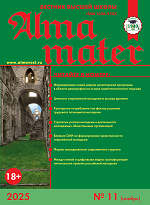Aleksandr A. Gorbunov, Cand. Sc. (Engineering), Docent, Orenburg State University, e-mail: gorbynovaleks@mail.ru
Aleksey D. Pripadchev, Dr. Sc. (Engineering), Professor, Orenburg State University, e-mail: apripadchev@mail.ru
Aleksandr G. Magdin, Cand. Sc. (Engineering), Orenburg State University, e-mail: magdin.sasha@yandex.ru
The problem of training professional engineers in the field of aerospace engineering is considered. The current situation in training specialists for the design and development of highly complex, intellectually intensive aerospace technology requires a radical change in the strategy and tactics of training, since the main characteristics of a graduate are his competence and mobility. This is an extremely difficult task, the responsibility for solving which lies with the modern teaching elite. In this regard, the emphasis in the study of academic disciplines is transferred to the process of cognition itself, the effectiveness of which completely depends on the cognitive interest of the student himself. The success of achieving this goal depends not only on what is learned, but also on how it is learned: individually or collectively, in authoritarian or humanistic conditions, based on attention, perception, memory or on the entire personal potential of a person, using active methods training. As an example, the process of forming the aerodynamic appearance of a mainline aircraft at the preliminary design stage is considered.
Keywords: professional engineer, expertise, mainline aircraft, cognitive interest, cognitive activity of the individual
References
1. Fokin, Yu.G. Theory and technology of teaching: activity approach: textbook for universities. 3rd edition, revised. Moscow: Academy, 2008. 240 p.
2. Zeer, E.F. Psychology of Professional Development. Moscow: Academy, 2006. 240 p.
3. Klimova, A.A., Vozhdaev, V.V. Application of modern numerical methods to study the aerodynamic characteristics of mechanized wings. Aviation Industry. 2021. No. 1. P. 14–20.
4. Pogosyan, M.A. Aircraft building - prospects of development. Proceedings of GosNIIAS. Series: Issues of avionics. 2018. No. 3 (36). P. 75–80.
5. Anisimov, K.S., Kazhan, E.V., Kursakov, I.A., Lysenkov, A.V., Podaruev, V.Yu., Savelyev, A.A. Development of aircraft appearance using high-precision methods of computational aerodynamics and optimization. Vestnik of the Moscow Aviation Institute. 2019. Vol. 26. No. 2. P. 7–19.
6. Mukohara, H., Anyoji, M. Computational Analysis of Compressibility Effect on Flow Fieldand Aerodynamics at Low Reynolds Numbers. Physics of Fluidsy. 2022. Vol. 34. No. 51.
7. Rahman, Md R. Computational Analysis of Aerodynamic Parameters for Supersonic Artillery Projectiles. SSRG International Journal of Mechanical Engineering. 2020. Vol. 7. No. 8. P. 5–17.
8. Choudhary, R., Garg, A.K. Fixed Point Results in Parametric Metric Space. International Journal on Emerging Technologies. 2019. Vol. 10. No. 2b. P. 100–104.












.png)






